Qingyan Bai
Edicho: Consistent Image Editing in the Wild
Dec 30, 2024Abstract:As a verified need, consistent editing across in-the-wild images remains a technical challenge arising from various unmanageable factors, like object poses, lighting conditions, and photography environments. Edicho steps in with a training-free solution based on diffusion models, featuring a fundamental design principle of using explicit image correspondence to direct editing. Specifically, the key components include an attention manipulation module and a carefully refined classifier-free guidance (CFG) denoising strategy, both of which take into account the pre-estimated correspondence. Such an inference-time algorithm enjoys a plug-and-play nature and is compatible to most diffusion-based editing methods, such as ControlNet and BrushNet. Extensive results demonstrate the efficacy of Edicho in consistent cross-image editing under diverse settings. We will release the code to facilitate future studies.
Real-time 3D-aware Portrait Editing from a Single Image
Feb 21, 2024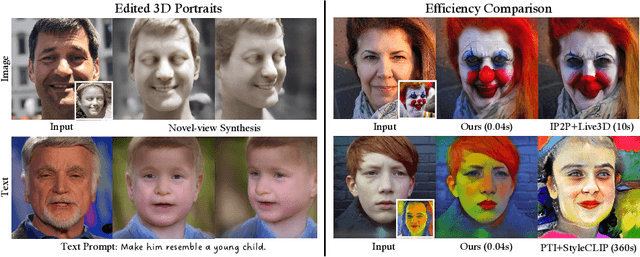

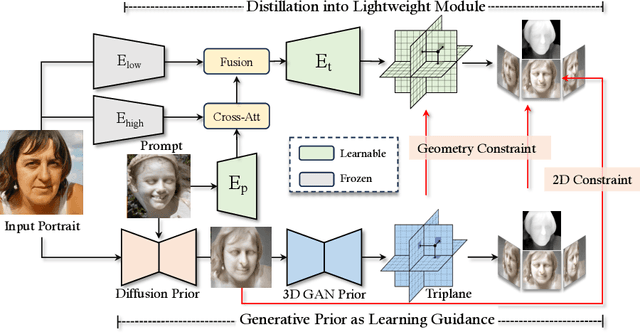

Abstract:This work presents 3DPE, a practical tool that can efficiently edit a face image following given prompts, like reference images or text descriptions, in the 3D-aware manner. To this end, a lightweight module is distilled from a 3D portrait generator and a text-to-image model, which provide prior knowledge of face geometry and open-vocabulary editing capability, respectively. Such a design brings two compelling advantages over existing approaches. First, our system achieves real-time editing with a feedforward network (i.e., ~0.04s per image), over 100x faster than the second competitor. Second, thanks to the powerful priors, our module could focus on the learning of editing-related variations, such that it manages to handle various types of editing simultaneously in the training phase and further supports fast adaptation to user-specified novel types of editing during inference (e.g., with ~5min fine-tuning per case). The code, the model, and the interface will be made publicly available to facilitate future research.
CoDeF: Content Deformation Fields for Temporally Consistent Video Processing
Aug 15, 2023



Abstract:We present the content deformation field CoDeF as a new type of video representation, which consists of a canonical content field aggregating the static contents in the entire video and a temporal deformation field recording the transformations from the canonical image (i.e., rendered from the canonical content field) to each individual frame along the time axis.Given a target video, these two fields are jointly optimized to reconstruct it through a carefully tailored rendering pipeline.We advisedly introduce some regularizations into the optimization process, urging the canonical content field to inherit semantics (e.g., the object shape) from the video.With such a design, CoDeF naturally supports lifting image algorithms for video processing, in the sense that one can apply an image algorithm to the canonical image and effortlessly propagate the outcomes to the entire video with the aid of the temporal deformation field.We experimentally show that CoDeF is able to lift image-to-image translation to video-to-video translation and lift keypoint detection to keypoint tracking without any training.More importantly, thanks to our lifting strategy that deploys the algorithms on only one image, we achieve superior cross-frame consistency in processed videos compared to existing video-to-video translation approaches, and even manage to track non-rigid objects like water and smog.Project page can be found at https://qiuyu96.github.io/CoDeF/.
Revisiting the Evaluation of Image Synthesis with GANs
Apr 04, 2023



Abstract:A good metric, which promises a reliable comparison between solutions, is essential to a well-defined task. Unlike most vision tasks that have per-sample ground-truth, image synthesis targets generating \emph{unseen} data and hence is usually evaluated with a distributional distance between one set of real samples and another set of generated samples. This work provides an empirical study on the evaluation of synthesis performance by taking the popular generative adversarial networks (GANs) as a representative of generative models. In particular, we make in-depth analyses on how to represent a data point in the feature space, how to calculate a fair distance using selected samples, and how many instances to use from each set. Experiments on multiple datasets and settings suggest that (1) a group of models including both CNN-based and ViT-based architectures serve as reliable and robust feature extractors, (2) Centered Kernel Alignment (CKA) enables better comparison across various extractors and hierarchical layers in one model, and (3) CKA shows satisfactory sample efficiency and complements existing metrics (\textit{e.g.}, FID) in characterizing the similarity between two internal data correlations. These findings help us design a new measurement system, based on which we re-evaluate the state-of-the-art generative models in a consistent and reliable way.
GLeaD: Improving GANs with A Generator-Leading Task
Dec 07, 2022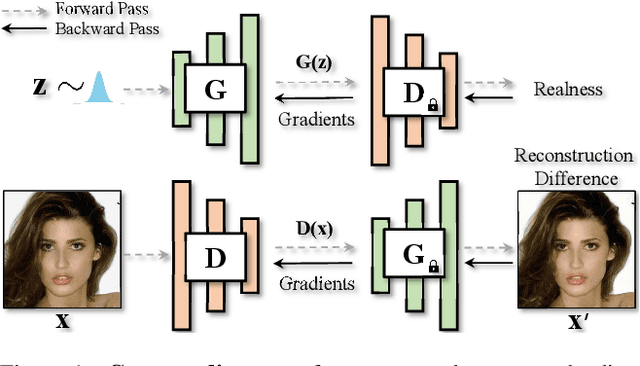



Abstract:Generative adversarial network (GAN) is formulated as a two-player game between a generator (G) and a discriminator (D), where D is asked to differentiate whether an image comes from real data or is produced by G. Under such a formulation, D plays as the rule maker and hence tends to dominate the competition. Towards a fairer game in GANs, we propose a new paradigm for adversarial training, which makes G assign a task to D as well. Specifically, given an image, we expect D to extract representative features that can be adequately decoded by G to reconstruct the input. That way, instead of learning freely, D is urged to align with the view of G for domain classification. Experimental results on various datasets demonstrate the substantial superiority of our approach over the baselines. For instance, we improve the FID of StyleGAN2 from 4.30 to 2.55 on LSUN Bedroom and from 4.04 to 2.82 on LSUN Church. We believe that the pioneering attempt present in this work could inspire the community with better designed generator-leading tasks for GAN improvement.
High-fidelity GAN Inversion with Padding Space
Mar 21, 2022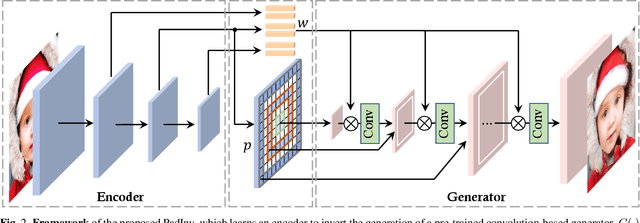


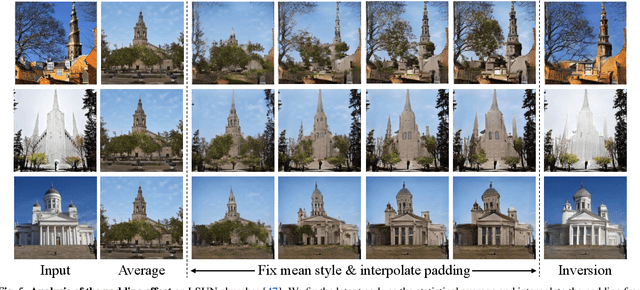
Abstract:Inverting a Generative Adversarial Network (GAN) facilitates a wide range of image editing tasks using pre-trained generators. Existing methods typically employ the latent space of GANs as the inversion space yet observe the insufficient recovery of spatial details. In this work, we propose to involve the padding space of the generator to complement the latent space with spatial information. Concretely, we replace the constant padding (e.g., usually zeros) used in convolution layers with some instance-aware coefficients. In this way, the inductive bias assumed in the pre-trained model can be appropriately adapted to fit each individual image. Through learning a carefully designed encoder, we manage to improve the inversion quality both qualitatively and quantitatively, outperforming existing alternatives. We then demonstrate that such a space extension barely affects the native GAN manifold, hence we can still reuse the prior knowledge learned by GANs for various downstream applications. Beyond the editing tasks explored in prior arts, our approach allows a more flexible image manipulation, such as the separate control of face contour and facial details, and enables a novel editing manner where users can customize their own manipulations highly efficiently.
StyleHEAT: One-Shot High-Resolution Editable Talking Face Generation via Pre-trained StyleGAN
Mar 17, 2022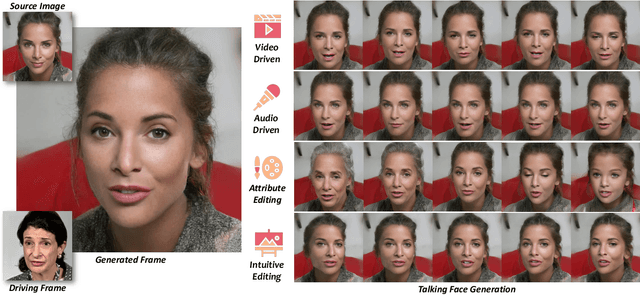
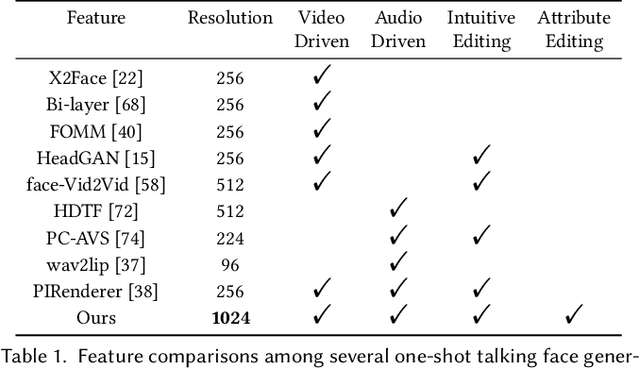
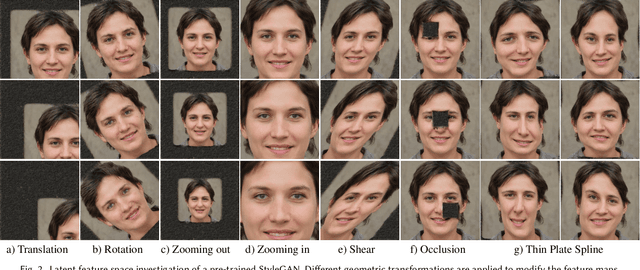

Abstract:One-shot talking face generation aims at synthesizing a high-quality talking face video from an arbitrary portrait image, driven by a video or an audio segment. One challenging quality factor is the resolution of the output video: higher resolution conveys more details. In this work, we investigate the latent feature space of a pre-trained StyleGAN and discover some excellent spatial transformation properties. Upon the observation, we explore the possibility of using a pre-trained StyleGAN to break through the resolution limit of training datasets. We propose a novel unified framework based on a pre-trained StyleGAN that enables a set of powerful functionalities, i.e., high-resolution video generation, disentangled control by driving video or audio, and flexible face editing. Our framework elevates the resolution of the synthesized talking face to 1024*1024 for the first time, even though the training dataset has a lower resolution. We design a video-based motion generation module and an audio-based one, which can be plugged into the framework either individually or jointly to drive the video generation. The predicted motion is used to transform the latent features of StyleGAN for visual animation. To compensate for the transformation distortion, we propose a calibration network as well as a domain loss to refine the features. Moreover, our framework allows two types of facial editing, i.e., global editing via GAN inversion and intuitive editing based on 3D morphable models. Comprehensive experiments show superior video quality, flexible controllability, and editability over state-of-the-art methods.
Identity-Guided Face Generation with Multi-modal Contour Conditions
Oct 10, 2021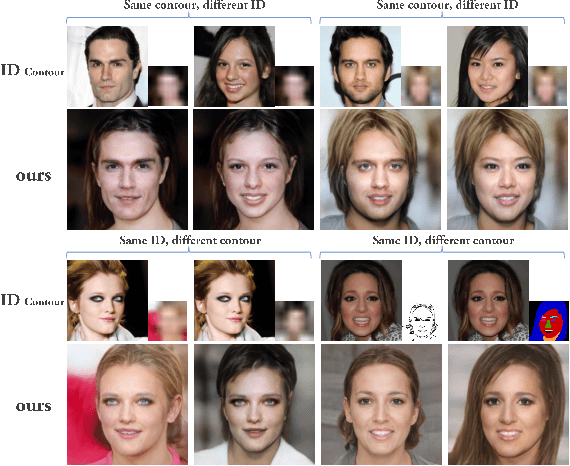
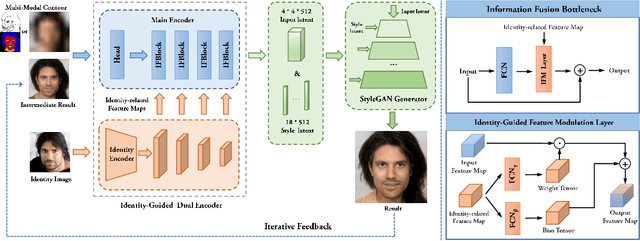
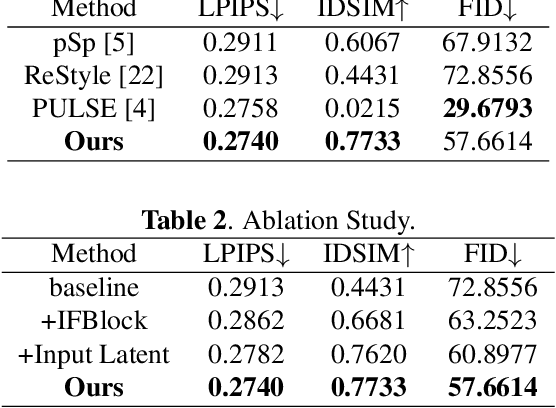
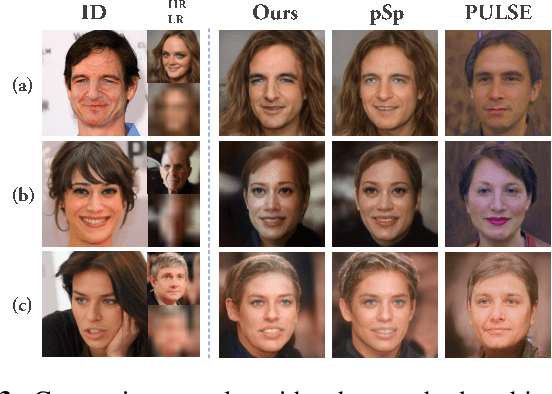
Abstract:Recent face generation methods have tried to synthesize faces based on the given contour condition, like a low-resolution image or a sketch. However, the problem of identity ambiguity remains unsolved, which usually occurs when the contour is too vague to provide reliable identity information (e.g., when its resolution is extremely low). In this work, we propose a framework that takes the contour and an extra image specifying the identity as the inputs, where the contour can be of various modalities, including the low-resolution image, sketch, and semantic label map. This task especially fits the situation of tracking the known criminals or making intelligent creations for entertainment. Concretely, we propose a novel dual-encoder architecture, in which an identity encoder extracts the identity-related feature, accompanied by a main encoder to obtain the rough contour information and further fuse all the information together. The encoder output is iteratively fed into a pre-trained StyleGAN generator until getting a satisfying result. To the best of our knowledge, this is the first work that achieves identity-guided face generation conditioned on multi-modal contour images. Moreover, our method can produce photo-realistic results with 1024$\times$1024 resolution. Code will be available at https://git.io/Jo4yh.
NTIRE 2021 Challenge on Perceptual Image Quality Assessment
May 11, 2021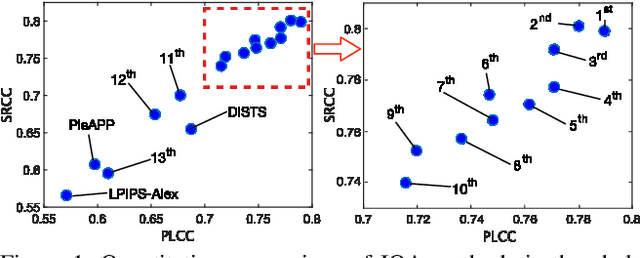
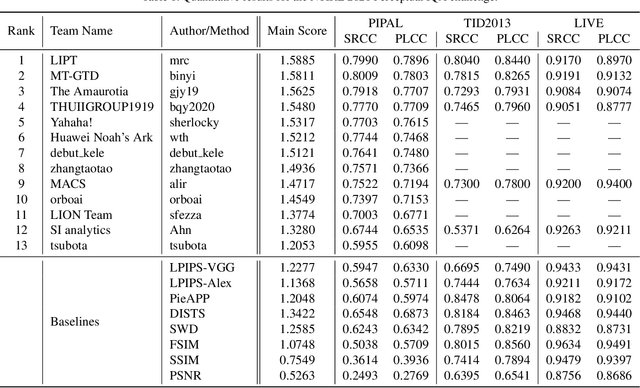
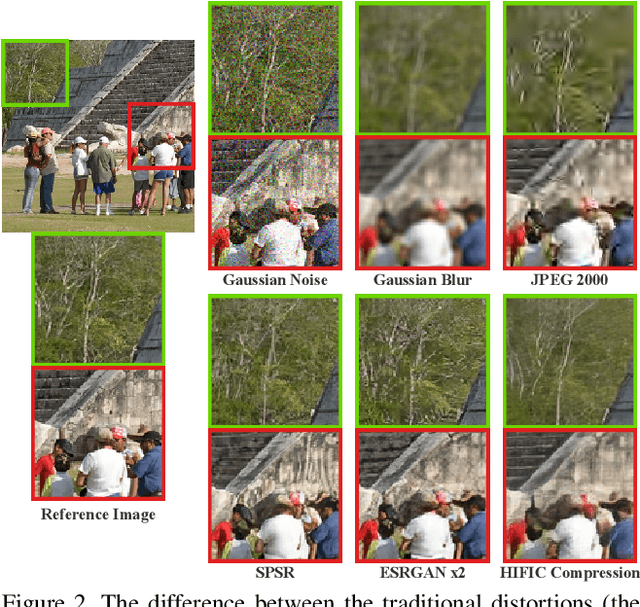
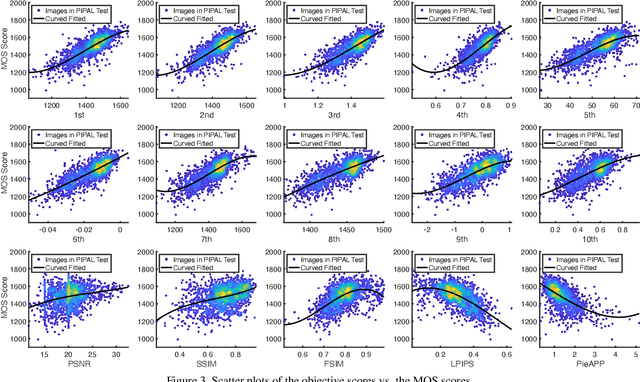
Abstract:This paper reports on the NTIRE 2021 challenge on perceptual image quality assessment (IQA), held in conjunction with the New Trends in Image Restoration and Enhancement workshop (NTIRE) workshop at CVPR 2021. As a new type of image processing technology, perceptual image processing algorithms based on Generative Adversarial Networks (GAN) have produced images with more realistic textures. These output images have completely different characteristics from traditional distortions, thus pose a new challenge for IQA methods to evaluate their visual quality. In comparison with previous IQA challenges, the training and testing datasets in this challenge include the outputs of perceptual image processing algorithms and the corresponding subjective scores. Thus they can be used to develop and evaluate IQA methods on GAN-based distortions. The challenge has 270 registered participants in total. In the final testing stage, 13 participating teams submitted their models and fact sheets. Almost all of them have achieved much better results than existing IQA methods, while the winning method can demonstrate state-of-the-art performance.
Region-Adaptive Deformable Network for Image Quality Assessment
Apr 23, 2021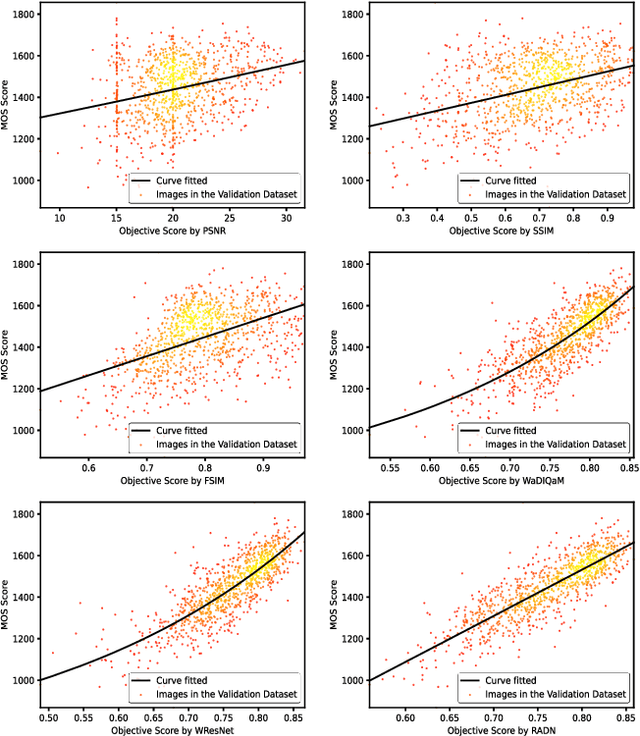
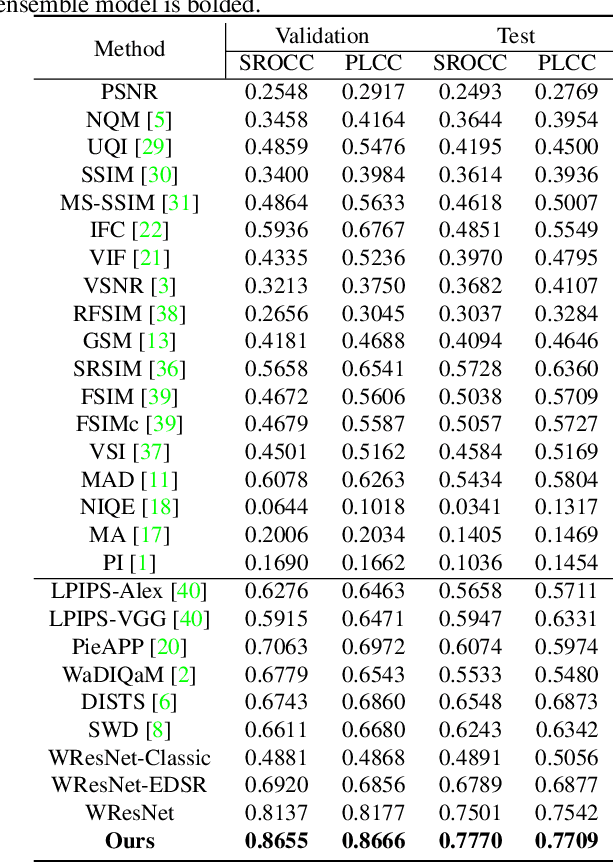

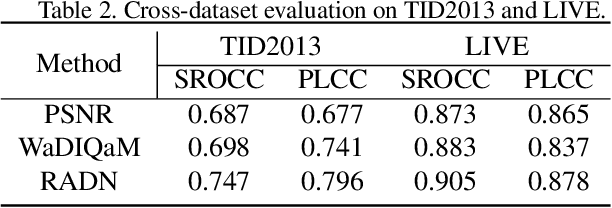
Abstract:Image quality assessment (IQA) aims to assess the perceptual quality of images. The outputs of the IQA algorithms are expected to be consistent with human subjective perception. In image restoration and enhancement tasks, images generated by generative adversarial networks (GAN) can achieve better visual performance than traditional CNN-generated images, although they have spatial shift and texture noise. Unfortunately, the existing IQA methods have unsatisfactory performance on the GAN-based distortion partially because of their low tolerance to spatial misalignment. To this end, we propose the reference-oriented deformable convolution, which can improve the performance of an IQA network on GAN-based distortion by adaptively considering this misalignment. We further propose a patch-level attention module to enhance the interaction among different patch regions, which are processed independently in previous patch-based methods. The modified residual block is also proposed by applying modifications to the classic residual block to construct a patch-region-based baseline called WResNet. Equipping this baseline with the two proposed modules, we further propose Region-Adaptive Deformable Network (RADN). The experiment results on the NTIRE 2021 Perceptual Image Quality Assessment Challenge dataset show the superior performance of RADN, and the ensemble approach won fourth place in the final testing phase of the challenge. Code is available at https://github.com/IIGROUP/RADN.
 Add to Chrome
Add to Chrome Add to Firefox
Add to Firefox Add to Edge
Add to Edge